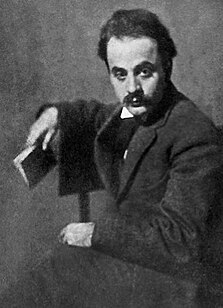 W
WGibran Khalil Gibran, usually referred to in English as Kahlil Gibran, was a Lebanese-American writer, poet and visual artist, also considered a philosopher although he himself rejected the title. He is best known as the author of The Prophet, which was first published in the United States in 1923 and has since become one of the best-selling books of all time, having been translated into more than 100 languages. Born in a village of the Ottoman-ruled Mount Lebanon Mutasarrifate to a Maronite family, the young Gibran immigrated with his mother and siblings to the United States in 1895. As his mother worked as a seamstress, he was enrolled at a school in Boston, where his creative abilities were quickly noticed by a teacher who presented him to photographer and publisher F. Holland Day. Gibran was sent back to his native land by his family at the age of fifteen to enroll at the Collège de la Sagesse in Beirut. Returning to Boston upon his youngest sister's death in 1902, he lost his older half-brother and his mother the following year, seemingly relying afterwards on his remaining sister's income from her work at a dressmaker's shop for some time.
 W
WAlfred Jarry was a French symbolist writer who is best known for his play Ubu Roi (1896), a pataphysical work which depicts the bourgeoisie as the super-mediocre. He coined the term and philosophical concept of pataphysics, which uses absurd irony to portray symbolic truths.
 W
WComte de Lautréamont was the nom de plume of Isidore Lucien Ducasse, a French poet born in Uruguay. His only works, Les Chants de Maldoror and Poésies, had a major influence on modern arts and literature, particularly on the Surrealists and the Situationists. Ducasse died at the age of 24.
 W
WNikolai Vladimirovich Nekrasov was a Soviet Esperanto writer, translator, and critic.
 W
WPierre Quillard was a French symbolist poet, playwright, translator, and journalist. An anarchist and supporter of Dreyfus, he later became one of the first people to defend the Armenians persecuted under the Ottoman Empire. In his youth, Quillard was a pupil of the Lycée Fontanes, where he counted Éphraïm Mickaël, Stuart Merrill, René Ghil, André Fontainas, Rodolphe Darzens, and Georges Vanor among his classmates.
 W
WMayer André Marcel Schwob, known as Marcel Schwob, was a French symbolist writer best known for his short stories and his literary influence on authors such as Jorge Luis Borges and Roberto Bolaño. He has been called a "precursor of Surrealism". In addition to over a hundred short stories, he wrote journalistic articles, essays, biographies, literary reviews and analysis, translations and plays. He was extremely well known and respected during his life and notably befriended a great numbers of intellectuals and artists of the time.
 W
WAlfred Vallette was a French man of letters.
 W
WJean-Marie-Mathias-Philippe-Auguste, comte de Villiers de l'Isle-Adam was a French symbolist writer.